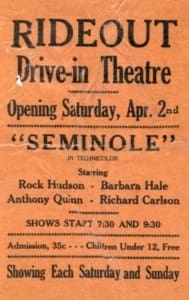Featured Videos and Film Posters
Atlantis Alive
Trailer for Creature From the Black Lagoon
Theatres
Clay Theater
(Previously Wilson’s Palace Opera House and Motion Picture Show)
 First license permit was received in 1916 by R. C. Wilson as Palace Opera House and Motion Picture Show. First recorded on Sanborn maps 1917. Location 420 – 422 Walnut Street. New theatre license permit dated October of 1936. First license permit showing name change was December 31, 1937 by R. C. Wilson. Clay Theatre license permit by Frank Bryant on March 22, 1939 and again on October 1, 1940, and October 1, 1941. (Thanks to Sara George Geiger, Neil Geiger, Jack Brooker and L. T. Robertson). The Florida Master Site file describes the theatre construction as Art Deco style.
First license permit was received in 1916 by R. C. Wilson as Palace Opera House and Motion Picture Show. First recorded on Sanborn maps 1917. Location 420 – 422 Walnut Street. New theatre license permit dated October of 1936. First license permit showing name change was December 31, 1937 by R. C. Wilson. Clay Theatre license permit by Frank Bryant on March 22, 1939 and again on October 1, 1940, and October 1, 1941. (Thanks to Sara George Geiger, Neil Geiger, Jack Brooker and L. T. Robertson). The Florida Master Site file describes the theatre construction as Art Deco style.
Rideout Drive-in Theatre
 The Rideout Drive-in consisted of a 16-mm projector, a rented film and a sheet stretched between the trees. You came in your car, paid $.35 per adult and sat in the yard on your blanket. The projection booth was a pole barn.
The Rideout Drive-in consisted of a 16-mm projector, a rented film and a sheet stretched between the trees. You came in your car, paid $.35 per adult and sat in the yard on your blanket. The projection booth was a pole barn.
“Sheet theaters” were not uncommon in the railroad era. Little theater companies would travel from stop to stop showing a film each night until the audience would dwindle, and on they went to the next stop. Rideout was unusual in that it was a more permanent business.
The movie, “Seminole”, premiered in 1953, so this showing might have been from Spring 1955, or so.



